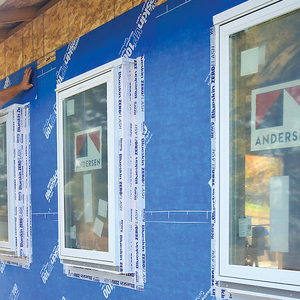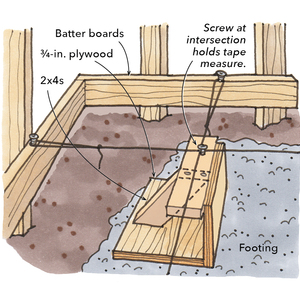My wife and I are looking for property in Maine. We now live in Massachusetts. We’d like to build, but we are not finding much land that does not come with an old Cape farmhouse. Some are just bad and a lot have had decent interior face lifts. We’ve have done a lot of homework on the pitfalls of old Capes and we understand a lot of the unsolved problems are in the cellar. Poor to no drainage and dirt floors cause rotting girders and joists. We carry a moisture meter and take lots of photos with the digital camera to see what we missed.
On the last trip to Maine my wife had to go it alone. She saw a 1830’s Cape, barn and shop that looked very good. Except, the pictures of the cellar. The rubble walls were reinforced with concrete walls and there was a concrete floor. Water stains and rust revealed some water problems that might be totally mitigated by installing gutters. BUT then, there were 20 or more lolly columns all over the place. This much added support made my heart drop. Plus, the columns all sat on top of 2X4 blocks. I guess so the bottom of the columns didn’t rust, until the block rots out under it! I could not see, nor did my wife remember, if the added columns were on girders or joists and the pictures did not reveal this. Am I right to fear all these lolly columns indicate stop-gap measures in avoidance of major repairs?
Obviously, I need to see for myself where the columns are placed and whether the girders and joists show rot or other compromise. But I wonder if others more knowledgeable than I have seen this and whether it is grounds for immediate concern.



















Replies
Since you are not trying to renovat an occupied house, why not try this approach. Find the house you like in the right location, etc. Then have the house either jacked up or moved off to the side, and have a proper basement/foundation and drainage system installed. Move the house back into position, and you're good for another hundred years.
"When asked if you can do something, tell'em "Why certainly I can", then get busy and find a way to do it." T. Roosevelt
I forgot to mention that we still cling to the hope of building a small, highy energy effcient, solar home. So the Cape will, we hope, be a stepping stone on that path.So, we don't want to get into major work on an old Cape if we can avoid it.We've been looking at old Capes for over a year now. Seeing all the associated problems with digging a big hole in the ground (which wants to fill up with water) here in New England, has made me believe that frost-protected shallow foundations are ideal for this area.If we could move a nice Cape onto a frost-protected foundation we could forget about all the nightmare cellars we've been in.Frost-protected shallow foundations are essentually a slab on grade with heavy perimeter footings plus exterior insulation extending down the side of the footing and extending 3 or more feet out from the building. This system captures geothermal heat rising to actually rise the frost line up to the insulation. This has been used in Scandinavia for many years. Heat loss through the bottom of the house is greatly reduced and you can stay away from all those water problems.I found out about frost-protected shallow foundations in my research into designing a solar home.
It is grounds for concern but that concern should not eliminate the house from consideration. You should investigate two things. First, is the floor frame adequately designed to support the spans? What would be the minimum number of posts to properly support the original frame? Second, is the frame in good condition? Is it rotted or compromised in any other way?
The odds are that someone put those posts in for a reason. If you are serious about buying this place, pay someone knowledgable and experienced in working with this type of building to come and give you an opinion which would include a price to fix whatever problems they find.
We do have a house inspector lined up who will review any final choices, but
it makes very good sense to find a specialist in this area.Just the kind of advice I needed.Thank you!
good advice about the inspector... or maybe a knowledgeable contractor
we've built many solar homes since 1975..
here's the one we live in
View Image
those are hot air collectors, single glazed..... we get 120 deg. air out of them on a day like this .. as soon as the sun comes out
good luck in your quest
Mike Smith Rhode Island : Design / Build / Repair / Restore
Edited 9/25/2005 8:20 pm ET by MikeSmith
Thanks for the photo. Very nice. I'm really into gambrels also. I love the observation port on top!
Can you look out there? Did you have to add structural bracing for it?Why did you choose solar air instead of solar hot water panels? My understanding is
the heat transfer is less efficient. Is it to avoid water pumps and antifreeze?I'd be very glad to hear your reasoning.
we did a lot of liquid collectors.. the liability and maintenance always bothered me
the hot air requires one blower and some ductwork... this blower has been working every heating season continuosly since 1985.. i've never even oiled it
the single glazing doesn't lose it's seal.. and since it's glass, it doesn't cloud up and delaminate like the fiberglass covers..
i've torn lot's of liquid collectors off roofs and thrown them in dumpsters.. glass glazed hot air collectors just keep right on working
we also did a lot of solar water / heat pump systems.. most of those were abandoned also.. too much maintenance
KISS is the ultimate.. if it requires more technology than calling an oil burner service guy, it will probably not last
nowadays we don't even do the solar hot air.... too expensive.. too many design constraints.. we do a lot of super insulation with low capacity heating systems... and we pay a lot more attention to designing for the non-heating months.. people tend to hunker down in winter.... but they really want to enjoy their homes year -round...
it's also amazing how limited the resale market is for soalr homes.... potential buyers are scared of the equipment and the operation, maintenance , and esthetics..
hey... wanna buy a geo-desic dome house ?Mike Smith Rhode Island : Design / Build / Repair / Restore
Mike, self engineered? Self built?
Joe H
we copied a lot from the early pioneers.. but developed our own systems and equipment over a 10 year period.. my house is the last solar home we built ( '85)..
one of the last to qualify for the $10K tax credits tooMike Smith Rhode Island : Design / Build / Repair / Restore
An inspector can tell you about the overall condition of the house and all its systems. A knowledgable contractor could size up the state of the framing, propose a recommended fix and give you a price to do the work. If you are serious about buying, both people are well worth it.
20 lally columns sounds like the house has some structural problems which were "quick fixed" by adding the lally columns. Properly installed cement filled lally columns should be installed every 6'-8' along the main carrying beam, depending on the building's construction, and reside on concrete pads. The house most likey has cracked floor joists and supporting beams due to moisture/insects. The last restoration I did of an 1880 carriage house had no less than 12 lally columns installed every 1' apart, made from nailed together 2x4's, and were replaced with proper columns.
JoeF
Renaissance Restorations
Antique & Victorian Home Restoration Services
http://www.renaissancerestorations.com